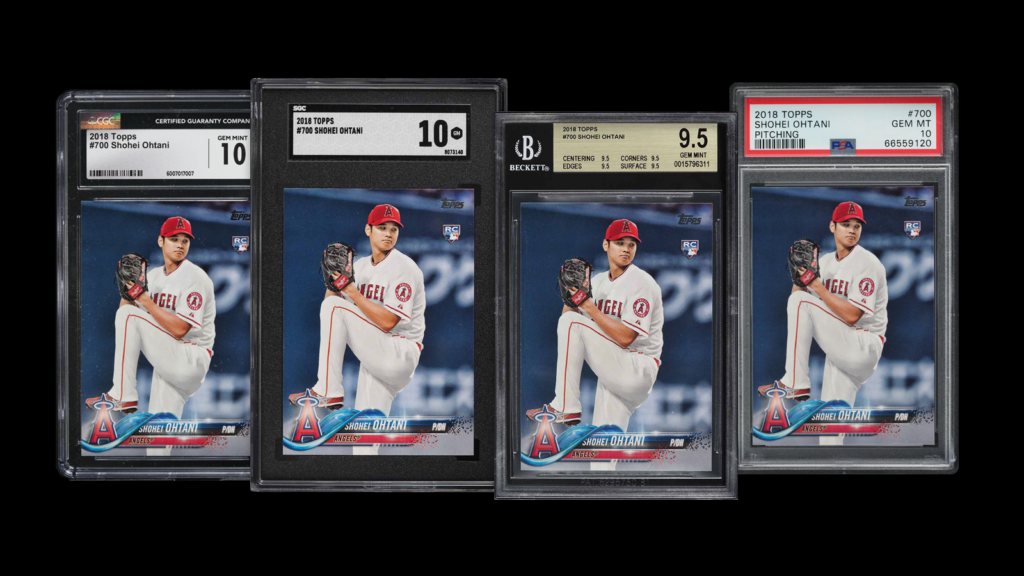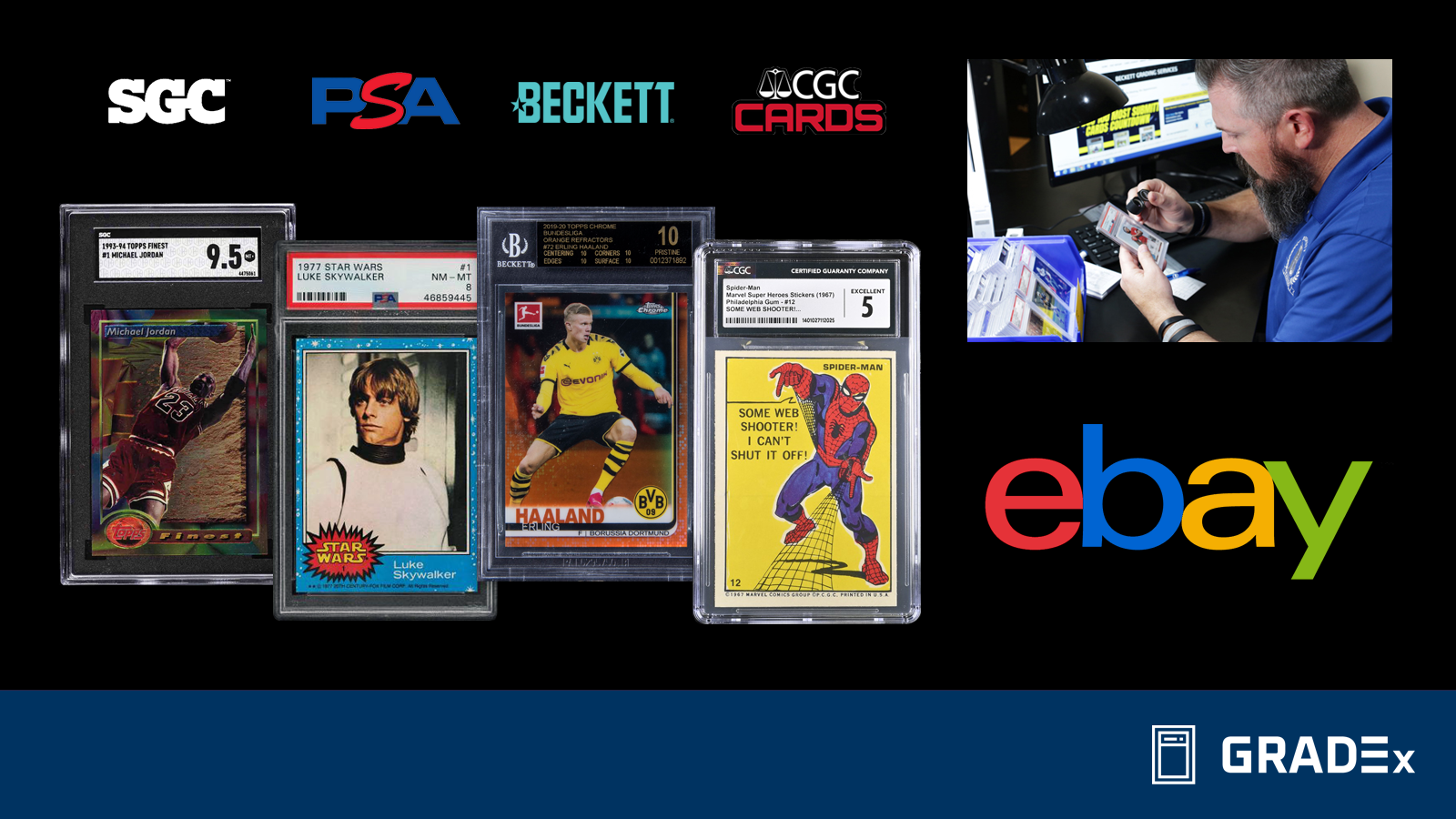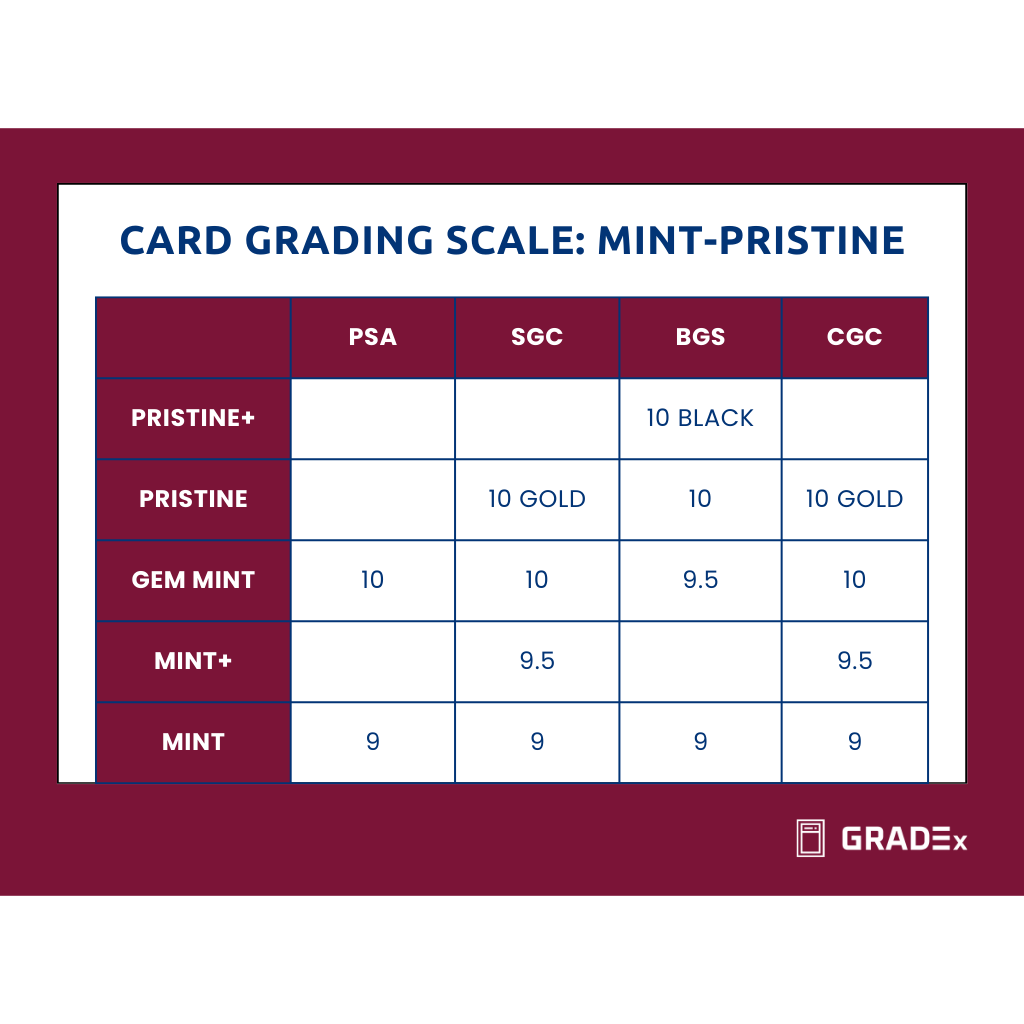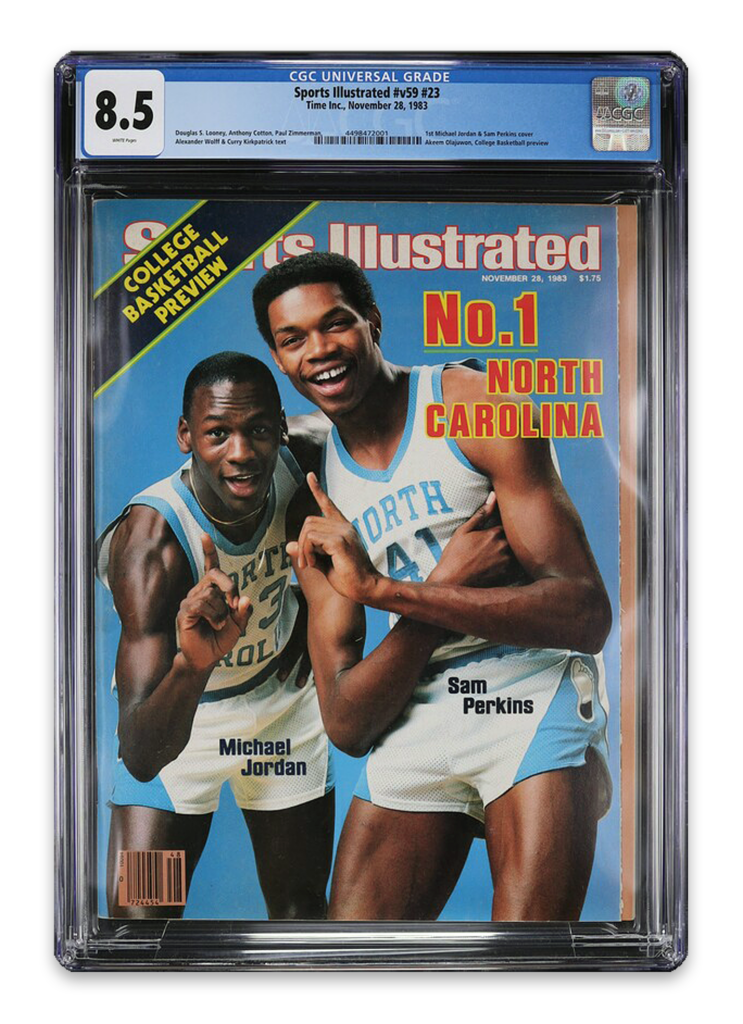PART 1: Intro to Grading & the Grading Process
In this chapter, we will delve into the intricacies of professional grading and the grading process. We will start with a comprehensive explanation of what professional grading entails, the reasons behind grading cards, and the steps involved in the grading process. Additionally, we will explore the grading scales used by the four major grading companies — PSA, SGC, BGS, and CGC.
By the end of this chapter, you will have a clear understanding of the fundamentals of third-party professional grading and its importance in the collectibles industry. You will become familiar with the key organizations involved in grading and gain insight into how grading impacts the industry as a whole, particularly in terms of its influence on secondary-market pricing. Additionally, you will be able to analyze the differences between various grading companies, enabling you to evaluate their approaches and standards effectively.
What is involved in Professional Grading?
The three primary functions of professional grading are: 1) authentication, 2) evaluation/certification and 3) preservation.
1. Authentication
Collectors send their cards to grading companies, where experts verify the authenticity of each card. Graders meticulously examine the cards to determine if they are genuine or if they are counterfeits or reproductions. Additionally, the grading companies check for any alterations or restorations that may have been made to the card. Alterations and restorations include but are not limited to trimming, color touch ups or structural repair.
This does not include the wiping or gentle cleaning of cards with a micro-fibre; the practice is generally accepted.
We define alterations as “changing the composition of a card in a small but significant way”. We define restoration as “renewal or repair of a card”.
The practice of restoration is accepted in the worlds of art, vintage books and stamps and does not necessarily devalue the item. Alteration or restoration of trading cards is frowned upon and not accepted by card grading companies. Examples of alteration include…
Trimming refers to cutting the edges of a card to make it appear sharper or to remove damage. Grading companies reject such alterations, and cards that do not meet the original size specifications are flagged as altered.
Recoloring involves adding or restoring color to faded or damaged areas of a card, such as touching up borders or artwork. This practice is prohibited, including attempts to modify a card’s appearance to resemble rarer versions.
Surface alterations, such as sanding, or applying substances to repair or improve a card’s gloss or fill in imperfections, are not allowed. These changes are often detectable through thorough inspection.
Again, wiping or cleaning debris from a card surface (with a gentle solvent) is not considered an alteration.
Reconstruction, which includes reattaching or repairing torn or missing parts of a card, such as its corners or edges, is also considered an unacceptable form of alteration.
A card deemed to have been altered or restored is typically given the grade of A, Authentic or Authentic Altered. This is lowest grade that can be given. Some card graders may reject the card completely and/or not grade the card at all.
2. Evaluation/Certification
Once a card is authenticated, its physical attributes are evaluated based on the condition of the corners, edges, surface, and centering and certified with a unique serial number and given a numerical grade out of 10.
3. Preservation
Another crucial aspect of grading is the preservation of the card’s condition. Once a card has undergone the processes of authentication, evaluation, and certification, it is placed in a protective casing to safeguard it from physical damage, environmental factors, and handling wear. This case is sonically and permanently sealed, ensuring that the card’s condition is maintained indefinitely and that it remains a secure and tamper-proof collectible.
Expertise
The experts responsible for grading trading cards must have extensive knowledge of the cards themselves, a deep understanding of printing technologies from various eras, a keen eye for detail, and a steady hand. They undergo rigorous and continuous training to maintain and improve their skills. Advanced technologies, such as high-resolution imagery and high-performance optical and illumination systems, are also employed to assist in the grading process. These technologies are particularly crucial for high-value cards, helping to identify any evidence of tampering or alteration.
The four major grading companies in the industry are PSA (Carlsbad, CA), SGC (Boca Raton, FL), BGS (Dallas, TX), and CGC (Sarasota, FL).
Protecting Your Cards and Collectibles
Supplies
Collectors looking to have their cards graded should ensure they use the appropriate supplies to protect them. Grading companies recommend submitting cards in a “penny sleeve” placed within a “semi-rigid” holder. Beckett Media provides a helpful article to guide you in choosing the right card supplies for your collection.
Insuring Your Collection
Insuring sports collectibles involves obtaining specialized coverage to protect items from risks such as theft, fire, water damage, or accidental breakage. Standard homeowners or renters insurance policies often provide limited or no coverage for collectibles, making it essential to seek dedicated insurance plans (or riders) tailored to the unique needs of collectors. These policies typically offer “agreed value” coverage, ensuring that the insured items are protected for their full market value without depreciation. Collectors may also benefit from additional features like worldwide coverage, protection during transit, and no deductibles for certain claims.
To secure insurance for sports collectibles, collectors usually need to provide an estimated value of their collection, supported by a spreadsheet, appraisals, receipts, or grading documentation for high-value items. Maintaining an up-to-date inventory is crucial for streamlining claims in case of loss or damage. Some insurers also offer automatic coverage for newly acquired items, ensuring that collections remain fully protected as they grow. By investing in specialized insurance, collectors can enjoy peace of mind, knowing their prized possessions are safeguarded against unforeseen events.
When it comes to trading cards, having a card graded provides a more accurate estimate of its value compared to an ungraded (raw) card.
Why Grade Cards and What’s Involved?
As we have just learned, authentication and preservation are two of the most important reasons to have cards graded. With each grading company boasting between 20 and 30 years of experience in the collectibles grading business, they have earned the trust of collectors. Collectors rely on the expertise and consistency of these grading companies.
Five to ten years ago, the cost to grade a card ranged from $10 to $200 USD per card, depending on the service speed and the card’s value. During the pandemic (2020 to 2022), the grading companies experienced significant backlogs due to a tremendous increase in demand for grading. Consequently, they temporarily increased their costs and turnaround times.
Today, the demand for grading remains high, with the four grading companies processing about 1.5 million cards per month. A major reason for this demand is the added secondary-market value that a high grade can bring to a card. For example, a 1986-87 Fleer Michael Jordan rookie card can sell for between $3,000 and $4,000 in strong “raw” (ungraded) condition. A Near-Mint Mint 8 graded copy sells for about $6,000, a Mint 9 for about $15,000, and a Gem Mint 10 for between $150,000 and $250,000 USD.
The increased value for high-grade copies is due to their scarcity. Grading companies track all the cards they grade and publish population reports showing the quantities. The highest grades — Pristine, Gem Mint, and Mint — are the most difficult to attain, making them less available for sale. The highest-rated cards of the best players, characters and subjects are the most in demand and the most valuable. Learn more about population reports here.
Grading Scales
Here are the grading scales used by PSA, SGC, BGS, and CGC. Each company’s grading scale ranges from a low of 1 to a high of 10. Additionally, all companies offer the grade of “A” or “Authentic,” which simply verifies the card as genuine. They also provide the service of grading the quality of the signature on certified autograph cards.
All four grading companies have this scale in common:
- A: Authentic — indicates that the card has been verified as genuine but is not assigned a numerical condition grade, often due to alterations, trimming, or severe wear, while still retaining collectible value as an authenticated item
- 1: Poor — typically exhibits extreme wear such as heavy creases, rounded corners, major surface damage, and possibly small tears or stains, but remains identifiable and intact enough to confirm authenticity
- 1.5: Fair — shows significant wear including heavy creases, rounded corners, surface scuffing, and possible staining or small tears, but remains structurally intact and clearly identifiable (with centering of 90/10 or better on the front and back)
- 2: Good — typically shows heavy wear including multiple creases, rounded corners, surface scuffing, and possible staining, but remains fully intact and clearly identifiable with no major pieces missing (with centering of 90/10 or better on the front and back)
- 2.5: Good+ — reflects heavy wear similar to a Good 2, such as rounded corners, creases, and surface issues, but with slightly better overall eye appeal or structural integrity that nudges it just above the baseline Good grade (with centering of 90/10 or better on the front and back)
- 3: Very Good — shows heavy wear such as multiple creases, rounded corners, and surface scuffing, but retains solid structural integrity and decent visual appeal for identification and collection (with centering of 90/10 or better on the front and back)
- 3.5: Very Good+ — shows considerable wear like creases, rounded corners, and surface flaws, but stands out from a standard VG 3 by offering slightly better centering, cleaner presentation, or improved structural integrity
- 4: Very Good to Excellent — typically shows moderate wear such as light creases, rounded corners, and minor surface flaws, but maintains solid visual appeal, structural integrity, and clear print quality (with centering of 85/15 or better on the front, 90/10 on the back)
- 4.5: Very Good to Excellent+ — shows moderate wear such as light creasing, corner rounding, and surface flaws, but offers slightly better centering (better than 85/15 on the front, 90/10 on the back), cleanliness, or overall eye appeal than a standard 4, making it a borderline candidate for the next grade
- 5: Excellent — displays moderate wear such as minor corner rounding, light surface scuffing, and slight print defects, but retains strong visual appeal, solid centering (85/15 or better on the front, 90/10 on the back), and overall structural integrity suitable for mid-grade collectors
- 5.5: Excellent+ — reflects moderate wear such as slight corner rounding, light surface scuffing, and minor print defects, but offers noticeably better centering (85/15 or better on the front, 90/10 on the back), edges, or overall eye appeal than a standard Excellent 5
- 6: Excellent to Near Mint — shows moderate wear such as slight corner rounding, minor surface blemishes, and light print defects, but maintains strong centering (80/20 or better on the front, 90/10 on the back), clean edges, and solid overall eye appeal that places it just below Near Mint condition
- 6.5: Excellent to Near Mint+ — shows moderate wear such as slight corner rounding, minor surface flaws, and decent centering (80/20 or better on the front, 90/10 on the back), but stands out from a standard 6 by offering improved visual appeal, sharper edges, or cleaner presentation that approaches Near Mint quality
- 7: Near Mint — exhibits only minor wear such as slight corner touches, subtle surface flaws, and light print imperfections, while maintaining strong centering (70/30 or better on the front, 90/10 on the back), sharp edges, and overall clean presentation suitable for high-quality collections
- 7.5: Near Mint+ — shows only minor wear such as slight corner touches or faint surface flaws, but stands out from a standard 7 by offering noticeably better centering (70/30 or better on the front, 90/10 on the back), sharper edges, and overall cleaner presentation
- 8: Near Mint to Mint — displays only slight wear such as subtle corner touches or faint surface flaws, with excellent centering (65/35 or better on the front, 90/10 on the back), sharp edges, and strong visual appeal that reflects high-quality preservation just below Mint condition
- 8.5: Near Mint to Mint+ — exhibits very minor wear such as faint corner touches or subtle surface flaws, with excellent centering (65/35 or better on the front, 90/10 on the back) and sharp edges, offering slightly superior overall eye appeal and condition compared to a standard 8
- 9: Mint — exhibits only minor flaws such as slight printing imperfections or barely touched corners, with excellent centering (60/40 or better on the front, 80/20 on the back), sharp edges, and clean surface that reflect near-perfect condition just shy of Gem Mint
Grading experts assign a rating between 1 and 10 based on the card’s defects. We will delve into more detail about what constitutes grades such as Gem Mint, Mint, Near-Mint Mint, and others.
Grading Scale Differences
Here are some specific differences between the grading companies:
- BGS is the only company that provides a breakdown of how each aspect of the card is graded — corners, edges, surface, and centering. These are known as subgrades.
- SGC and CGC are the only companies with a Mint+ grade (9.5), which falls between Mint and Gem Mint.
- BGS assigns a 9.5 for Gem Mint, while PSA, SGC and CGC use 10 for Gem Mint.
- SGC, BGS and CGC are the only companies to offer a Pristine grade, which is higher than Gem Mint.
- SGC highlights its Pristine grade with a gold trim around the label and the letters “PRI” next to the 10.
- CGC also highlights its Pristine grade with a vibrant label with a gold background and gold foil embossing of the 10 and the word “PRISTINE” above the 10.
- BGS is the only company with a “Pristine+” grade, distinguished by a Black Label and gold printing. What distinguishes a Black Label 10 from a Pristine 10 is that all four subgrades (corners, edges, surface and centering) have earned a grade of 10. This is the highest attainable (and most valuable) grade in the industry.

The chart highlights that differences in grades and scales become noticeable for grades above Mint 9. These higher grades are where grading companies truly distinguish themselves. Collectors and investors should carefully evaluate the advantages and disadvantages of each grading company before making buying or grading decisions.
You can review a more detailed breakdown of grades above Mint 9.
Also, check out this comprehensive comparison of PSA, SGC, BGS and CGC.
At times, PSA will add a two-letter “qualifier” next to the numerical grade. Learn all about qualifiers here.
Grading Process In Action
Below are several helpful links and videos that provide a detailed overview of how the trading card grading process works. These resources cover everything from preparing your cards for submission to understanding the grading criteria used by the grading companies. You’ll also find insights into the step-by-step procedures, including authentication, grading, and encapsulation, as well as tips for ensuring your cards are protected during the process. Whether you’re new to grading or looking to deepen your knowledge, these materials will guide you through the entire journey and help you make informed decisions about your collection.
“CGC Grade School: How Graders Grade Your Cards”
“MLB pitcher gets cards graded by CGC on The Card Life”
“PSA Sports Trading Card Grading Process”
PART 2: Grading & e-Commerce
This section will delve into the evolution of trading cards in the internet age. We will analyze the impact of the digital era on the trading card industry, explore the introduction of eBay and its online auction platform for trading cards, and present insights from industry insiders on the convergence of eBay with professionally graded cards.
By the end of Part 2, you will have the ability to analyze how professional grading impacts consumer confidence in buying and selling cards through e-commerce. You will also be equipped to identify various e-commerce platforms available for online transactions. Additionally, you will learn to evaluate the pros and cons of using different e-commerce platforms for buying and selling. Finally, you will gain insights into eBay’s influence on the industry, both from a historical perspective and its current role in shaping the market.
Card Grading Historical Timeline
In 1991, PSA introduced professional grading to the sports card market, a natural progression given their parent company’s extensive experience in grading stamps, coins, and money. Initially, collectors resisted, believing they could grade their own cards. However, they soon recognized the benefits of professional grading, particularly in enhancing resale value.
The mass introduction of the Internet in 1994 prompted collectors to speculate on its impact on the trading card industry. The landscape changed dramatically with the launch of eBay in 1995 and its online auction platform. By 1997 and 1998, eBay had become a significant player in the secondary market for trading cards, allowing collectors to buy and sell cards from anywhere with just a few clicks.
We encourage you to review the fascinating story of how eBay got started.
As eBay and online sales grew in popularity, the need for authentication increased. As with any expanding industry, some individuals attempted to exploit the system. Unauthorized, reprinted, and fake cards became more prevalent, and collectors sought greater confidence when purchasing online, especially for high-end cards. Graded cards provided that assurance.
The late 1990s saw continued growth in online transactions and the entry of two new grading companies: SGC in 1998 and BGS in 1999. Alongside PSA, these companies remained the leaders in the grading industry for the next 20 years.
In 2021, CGC (then named CSG for sports cards) began grading trading cards, building on their long history of being the industry leader in grading comic books and magazines since 2000.
Besides eBay, some of the top marketplaces for trading cards and collectibles include:
- COMC (review an extensive guide to COMC here)
- Fanatics Collect
- Goldin
It is important to note that certain collectibles fetch higher prices in different marketplaces. For example, Goldin’s marketplace and auction site is an excellent choice for selling high-end collectibles valued at $1,000 or more. Meanwhile, eBay and COMC dominate the lower-end market.
eBay Sales Data of Trading Cards
From 2019 to 2024, eBay experienced remarkable growth in trading card sales, reflecting the booming interest in collectibles. In 2020 alone, eBay reported a 142% increase in trading card sales compared to the previous year, driven by the pandemic and a surge in nostalgia-fueled hobbies. Categories like Pokémon cards saw a 574% increase in sales, while basketball cards grew by 373%, highlighting the diverse appeal of trading cards.
By 2021, eBay’s trading card marketplace had surpassed $2 billion in transactions, with over 4 million buyers engaging on the platform. This growth continued into 2022 and beyond, as rare and graded cards, particularly those featuring iconic athletes or characters, fetched record-breaking prices.
In 2023, eBay introduced features like live auctions and enhanced integration with grading services, further streamlining the buying and selling process. These innovations attracted both seasoned collectors and newcomers, contributing to a thriving marketplace. By 2024, trading cards remained one of eBay’s most dynamic categories, with millions of listings and a global community of collectors.
Source: ebay.com
Conclusion
During the early to mid-1990s, as collectors and hobbyists grew increasingly comfortable with the concept of professional grading, a remarkable synergy emerged with the meteoric rise of eBay. This transformative period created a perfect storm, revolutionizing how collectibles were bought and sold. Over time, as the popularity of online transactions surged, grading companies evolved to meet the growing demands of collectors. They introduced innovative advancements and refined their processes, ensuring greater accuracy and reliability in grading. The dynamic interplay between the expanding online marketplace and the advancements in professional grading cemented a new era for collectors, fostering trust and confidence in transactions conducted from across the globe.
—
Next, Chapter 7: The Market, Investing & 2020 Renaissance
You may also like…






